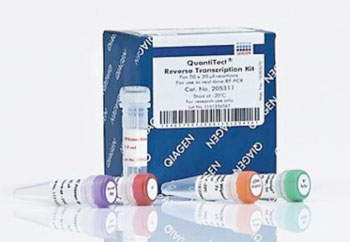Independent Prognostic Factor for Acute Myeloid Leukemia Discovered
By LabMedica International staff writers
Posted on 06 May 2015
Acute myeloid leukemia (AML) is a clonal disorder involving a hierarchy of leukemic cells, and with investigations of the mechanism of AML, many epigenetically-regulated genes have been approved as new prognostic factors for the disease.Posted on 06 May 2015
The protein transcription factor hairy and enhancer of split-1 (HES1) is the target of Notch signaling which is reported to affect cell differentiation and maintain the cells in the resting phase (G0) in various tissues including the hematopoietic tissue.

Image: QuantiTect Reverse Transcription Kit (Photo courtesy of Qiagen).
Scientists at the Tianjin Medical University Cancer Institute and Hospital (Tianjin, China) analyzed HES1 expression in a group of non-core binding factor AML patients and correlated its expression with the overall survival and relapse-free survival of AML patients. They collected bone marrow mononuclear cells (BMNCs) with Ficoll of 40 newly diagnosed AML patients between August 2008 and January 2014. Baseline morphology, cytogenetics, and cell surface antigen analysis were performed as part of the routine clinical evaluation of the patients.
Total ribonucleic acid (RNA) of AML BMNCs was extracted and reverse transcription was achieved using QuantiTect Reverse Transcription Kit (Qiagen NV; Venlo, the Netherlands. Real-time polymerase chain reaction was performed using ABI-Prism 7500 Sequence Detector (Thermo Fisher Scientific; Waltham, MA USA). The top 50% of AML cases with the high HES1 expression were compared with the rest of the AML cohort. Overall survival was calculated from the date of diagnosis until the date of death from any cause or until the date of final follow-up. Relapse-free survival was determined for responders from the time of diagnosis until relapse or death from any cause.
The investigators showed that the lower-expression group had a shorter overall survival time 37.6 ± 1.6 versus 54.0 ± 1.3 months, and shorter relapse-free survival time compared with those of the high-expression group 28.6 ± 1.8 months versus 44.8 ± 2.1 months. The authors concluded that expression of HES1 is a useful prognostic factor for patients with non-core binding factor AML. The study was published on April 22, 2015, in the journal OncoTargets and Therapy.
Related Links:
Tianjin Medical University Cancer Institute and Hospital
Qiagen NV
Thermo Fisher Scientific














